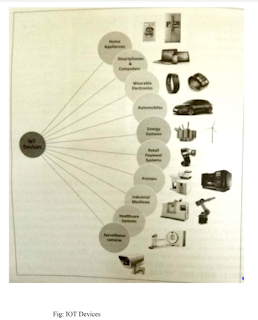PHYSICAL DESIGN OF IOT
1. Things in IOT
The “things” in IOT usually refers to IOT devices which have unique identities
and can perform remote sensing , actuating and motitoring capabilities.
IOT devices can
a. Exchange data with other connected devices and applications (directly or
indirectly)
b. Collect data from devices and process the data either locally or
c. Send the data to centralized servers or cloud-based applications back-end for
processing the data,
d. Perform some tasks locally and other tasks within the IOT infrastructure, based
on temporal and space constraints.
An IOT device may consists of several interfaces for connections to other
devices, both wired and wireless.
i. I/O interfaces for sensors
ii. Interfaces for Internet connectivity
iii. Memory and storage interfaces and
iv. Audio/video interfaces.
IOT devices can collect various types of data from the attached sensors,such as
temperature, humidity, light intensity.
The sensed data can be communicated either to other devices or cloud-based
servers/storage.
2.IOT Protocols
Link Layer:
Link layer protocols determine how the data is physically sent over the network’s
physical layer or medium.
The scope of the link layer is the local network connection to which host is
attached.
Hosts on the same link exchange data packets over the link layer using link layer
protocols.
I. 802.3 - Ethernet :
IEEE 802.3 is a collection of wired ethernet standards for the link layer.
The shared medium in Ethernet can be a coaxial cable, twisted-pair wire or
optical fiber.
The shared medium carries the communication for all the devices on the
network.
II. 802.11 - WIFI :
IEEE 802.11 is a collection of wireless local area network(WLAN)
communication standards.
These standards provide data rates from 1Mb/s to 6.75 Gb/s.
III. 802.16 - WiMax :
It is a collection of wireless broadband standards, including extensive
descriptions for the link layer.
WiMax standards provide data rates from 1.5 Mb/s to 1Gb/s.
IV. 802.15.4 - LR-WPAN :
IEEE 802.15.4 is a collection of standards foe low-rate wireless personal area
networks(LR-WPANs).
These standards form the basis of specifications for high level communication
protocols such as ZigBee.
This provides data rates from 40Kb/s to 250kb/s.
V. 2G/3G/4G - Mobile communication:
There are different generations of mobile communication standards including
second generation(GSM and CDMA), third generation(UMTS and CDMA200),
fourth generation(LTE).
Iot devices based on these standards can communicate over cellular networks
Data rates for these standards range from 9.6Kb/s upto 100Mb/s.
Network/Internet Layer :
The network layers are responsible for sending of IP datgrams from the source
network to the destination network.
This layer performs the host addressing and packet routing.
The datagrams contain the source and destination address whichare used to route
them from source to destination across multiple networks.
I. IPv4
Internet Protocol version 4 is the most deployed internet protocol that is used to
identify the devices on a network using a hierarchical addressing scheme.
It uses a 32-bit address scheme that allows total of 2 power 32address.
II. IPv6
It is the newest version of internet protocol and successor to IPv6.
IPv6 uses 128-bit address scheme that allows total of 2 power 128 addresses.
III. 6LoWPAN
IPv6 over Low power Wireless Personal Area Networks(6LoWPAN) brings IP
protocol to the low power devices which have limited processing capability.
It operates in the 2.4Ghz frequency range and provides data transfer rates of
250Kb/s.
Transport Layer
It provide end-to-end message transfer capability independent of the underlying
network.
The message transfer capability can be set up on connections, either using
handshakes or without handshakes/acknowledgements.
It provides functions such as error control, segmentation, flow control and
congestion control.
I.TCP
Transmission Control Protocol is the most widely used transport layer protocol,
that is used by web browsers, email programs and file transfer.
It also provides error detection capability so that duplicate packets can be
discarded and lost packets are retransmitted.
II. UDP
UDP is a connectionless protocol.
It is useful for time-sensitive applications that have very small data units to
exchange and do not want the overhead of connection setup.
It is a transaction oriented and stateless protocol.
It does not provide guaranteed delivery, ordering of messages and duplicate
elimination.
Application Layer
It defines how the applications interface with the lower layer protocols to send the
data over the network.
Application layer protocols enable process-to-process connections using ports.
1. HTTP
Hypertext Transfer Protocol(HTTP) is the application layer protocol that forms
the foundation of the WWW.
The protocol follows a request-response model where a client sends requests to a
server using the HTTP commands.
It is a stateless protocol and each HTTP request is independent of the other
requests.
2. CoAP
Constrained Application Protocol(CoAP) is an application layer protocol for
machine-to-machine(M2M) applications.
Meant for constrained environments with constrained devices and constrained
networks.
CoAP is designed to easily interface with HTTP.
3. WebSocket
WebSocket protocol allows full-duplex communication over a single socket
connection for sending messages between client and server.
It is based on TCP and allows streams of messages to be sent back and forth.
4. MQTT
Message Queue Telemetry Transport(MQTT) is a light weight messaging.
It is based on publish-subscribe model.
It uses a client-server architecture where client connects to the server and
publishes messagesto topics on the serever.
5. XMPP
Extensible Messaging and Presence Protocol(XMPP) is a protocol for real-time
communication and streaming XML data between entities.
XMPP allows sending small chunks of XML data from one network entity to
another.
It is a decentralized protocol.
It uses a client-server architecture.
6. DDS
Data Distribution Service(DDS) is a data-centric middleware standard for device-
to-device or machine-to-machine communication.
It uses a publish-subscribe model where publishers create topics to which
subscribers can subscribe.
It provides quality-of-service control and configurable reliability.
7. AMQP
Advanced Message Queuing Protocol(AMQP) is an open application layer
protocol for business messaging.
It supports both point-to-point and publisher/subscriber models.
AMQP brokers receive messages from publishers and route them over
connections to consumers.






No comments:
Post a Comment